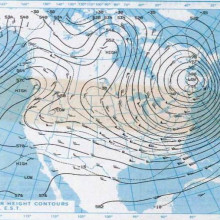This week, Hell literally froze over, as the small Michigan town of Hell experienced temperatures of minus 17 degrees Celsius. And Hell wasn't alone temperatures across the United States have plummeted to record lows as cold air from the Arctic has reached much lower latitudes than is usual. To explain how this has come about, here's your Quick Fire Science about the polar vortices with Kate Lamble and Dominic Ford
In this episode

00:00 - Polar Vortices
Polar Vortices
This week, Hell literally froze over, as the small Michigan town of Hell experienced temperatures of minus 17 degrees Celsius. And Hell wasn't alone temperatures across the United States have plummeted to record lows as cold air from the Arctic has reached much lower latitudes than is usual...
To explain how this has come about, here's your Quick Fire Science about the polar vortices with Kate Lamble and Dominic Ford.
- Around the Arctic and Antarctic, air rotates in structures called polar vortices which mix very little with air at lower latitudes.
- In Antarctica, this mass of air is so enclosed that very little warm wet air ever blows in with any likelihood of forming rain.
- As a result, only a few centimetres of snow fall across Antarctica each year, meaning that much of the continent is officially classified as a desert.
- A similar Arctic polar vortex is normally centred around Baffin Island in northern Canada.
- But in recent days, a weather system over the Pacific has pushed northwards, forcing part of the polar vortex south over the US and Canada.
- In North Dakota's largest city of Fargo, this has led to temperatures have plunged as low as -35C -- cold enough that frostbite can set in even underneath clothing.
- In Indianopolis meanwhile, all non-emergency driving has been banned, and people have been urged to stay indoors.
- In 2010, a similar migration of the Arctic polar vortex led to incredibly harsh weather across Europe.
- As the fast moving belt of air which serves as the boundary between warmer southern air and cold polar air is driven by temperature differences it weakens when the arctic is at higher temperatures
- The Arctic is currently warming more rapidly than lower latitudes, and White House Science Advisor Dr. John Holdren argues that this makes the polar vortex's boundary less well defined, increasing the chances of cold air passing over the US and Europe.
- As a result, he argues that global warming could, rather counter-intuitively, lead to more extreme cold spells in the future.










Comments
Add a comment